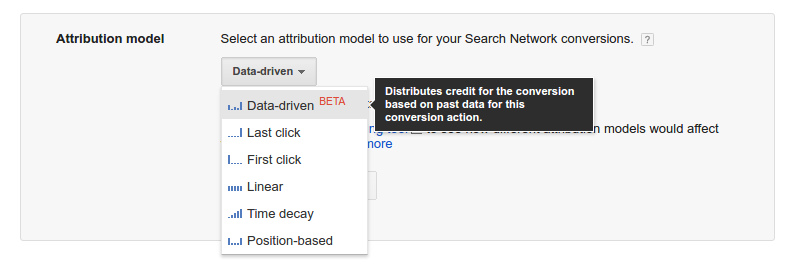Attribution can be complicated for advertisers.
An attribution model is the rule, or set of rules, that determine how credit for sales and conversions are assigned to touchpoints in the conversion path. It’s imperative for advertisers to understand how each of these channels relate and support each other throughout the shopper’s journey.
But touchpoints can vary from email, to social media, SEO and PPC and historically it’s been very difficult to attribute sales to specific advertising efforts.
Google Attribution, is new product that aims to finally close the gap on reporting and inform advertisers how to attribute each conversion to each sale.
For the first time, Google Attribution makes it possible for every marketer to measure the impact of their marketing across devices and across channels — all in one place, and at no additional cost.
According to Google’s announcement, with today’s complex customer journey, your business might have a dozen interactions with a single person – across display, video, search, social, and on your site or app. And all these moments take place on multiple devices, making them even harder to measure.
Marketers have been trying to demystify attribution for years but non of the available solutions have been sufficient.
To start most attribution tools are hard to set up. It’s also pretty common to lose track of customers when they move between devices, and finally most of these models are not integrated with ad tools – which makes it nearly impossible to take any sort of action regarding budget allocation.
Although CPC Strategy declared “The Death of Last Click” in 2016, many marketers (externally) are still using last-click attribution, mostly because the entire process is just too difficult to accurately coordinate.
With Google Attribution, now advertisers can finally understand how each of their marketing efforts work together.
Integrations with AdWords, Google Analytics and DoubleClick Search make it easy to bring together data from all your marketing channels. The end result is a complete view of your performance.
Google Attribution also makes it easy to switch to data-driven attribution.
What is Google’s Data-Driven Model?
One of the latest models introduced to help advertisers gain a better understanding of attribution is Google’s Data-driven model.
Unlike rules-based models, data driven attribution uses machine learning to evaluate all the converting and non-converting paths across your account and identifies the proper credit for each interaction.

The model considers:
-
- Number of ad interactions
- Order of exposure
- Ad creative
- Other factors to determine which keywords and clicks are the most effective at driving results
This is Google’s attempt to build an all encompassing attribution measurement that can be applied to campaigns and immediately start providing actionable data.
In other words, Data-driven looks at all the clicks on your search ads, then it compares the click paths of customers who convert vs. the click path of customers who don’t.
The model identifies patterns of clicks that lead to conversions and then they basically overlay that onto your campaigns and tell you how valuable your campaigns are based on this wide array of search behavior.
Google Attribution: Is it Important?
Google has always had trouble tracking across devices because people don’t usually stay logged into Google.
“Facebook is much better at attribution because they have single sign-on (SSO). It’s interesting in the digital world because SSO is key to being able to reach users as opposed to being able to reach cookies. There’s a big distinction between cookie-based targeting vs. user-based targeting,” Lewis Brannon, Paid Search Manager at CPC Strategy said.

“Google’s always been all about cookie-based targeting because all of their advertising tools are tied to targeting either searches, keywords or targeting browsers based on cookie information.”
Let’s see how this applies to a real life example:
An advertiser places an AdWords code on your website. “Jody” (a potential customer) goes to your website and views the swimsuit page. Advertisers are able to use this data to target Jody.

But what if the next time someone uses Jody’s computer, it’s not Jody. Instead, it’s her brother – Ryan. Unfortunately, because Google isn’t always able to track the user based on a SSO, you’re stuck to only targeting the actual browser that performed the behavior not necessarily the person.
So in theory, Ryan could use his sister’s computer and Google will serve him the same swimsuit ads (even though he’s not interested in those products).
This is because Jody’s browsing behavior is the only information Google has to tie it back to.
Whereas because of Facebook’s sign-in feature, the platform can target Jody and Ryan separately because they each have an individual Facebook account log ins (which they will use to log into all their devices including tablets, phones, and computers).
“That single sign in gives advertisers the ability to target individuals rather than targeting browsers based on cookie data,” Brannon said.
Google announced in 2017 that they are getting much better at single sign in targeting. If you’re logged into Google (for example through your work Gmail account) on your computer and your phone, then you’re a good target for Google advertisers.
But, if you’re not logged into Google across multiple devices (for example, at work you use Chrome but at home you use Mozilla), it gets difficult to track your behavior.
“As that pertains to data driven attribution, the real benefit comes when Google is able to track conversions across multiple touch points and devices. Prior to Google’s advances in attribution, we couldn’t really trace the customer journey; we were stuck with last click only, now we can do a better job of seeing the holistic view of our campaigns and how they work together.”
“With the data-driven model and machine learning, Google is trying to determine which of those touchpoints was the most valuable and will distribute the conversions in a way that assigns the proper value to each one,” Brannon said.
“This is Google’s way of saying: Google Attribution has arrived and you should use it and don’t just think about last click anymore.”
According to Brannon, it can take a little while before the machine-learning model has enough data to run up to full speed.
“You might notice a dip in conversions in the beginning, because Google is trying to redistribute between campaigns and draw from historical data. But once you’re fully up and running, it should be (per Google’s recommendation) good to go.”
Google Attribution is currently in beta. We will update you will more information, once it becomes available.
For more on Google Attribution, email [email protected]
You Might Be Interested In













